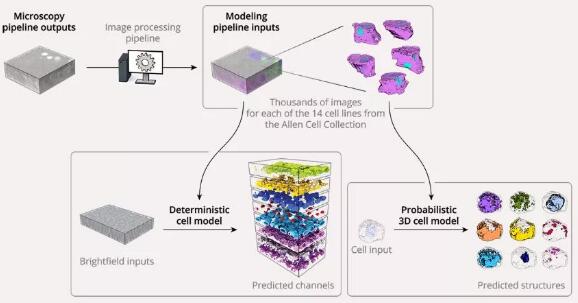Release date: 2018-05-15
How do human cells fight disease? This has always been one of the problems scientists are exploring. With the continuous development of medicine, doctors can use microscopes, X-rays and other means to view the state of human cells. However, the information that these tools can provide is still limited. At the same time, before the doctor observes, the original morphology of the cells may also change due to factors such as genetic changes, special dyes or strong light. For individual cells, the observation will be more difficult.
Therefore, in order to more fully understand the complete process of each cell's response to disease, researchers from the Allen Institute have recently used artificial intelligence to create the first complete 3D model of human cells, showing that different parts and structures within the cell are How it works. The Allen Institute is a renowned bioscience institute in Seattle, USA, and founder Paul Allen is also a co-founder of Microsoft Corporation.

Schematic diagram of AI generation of induced functional stem cell 3D model (Source: Allen Institute official website)
The model demonstrates the appearance and structure of typical induced pluripotent stem cells (hiPSCs) in humans. To train the artificial intelligence that created this model, the researchers scanned thousands of cells and obtained detailed information and data about those cells.
Based on this information, AI generates a cellular model that predicts the possible location of each organelle in the cell and how it matches the rest of the cell. At the same time, the researchers used artificial intelligence to create a probabilistic model that simulates the location of organelles in the cell, given the size, shape, and location of the nucleus.

3D model image of cells generated by AI (Source: Allen Institute official website screenshot)
For doctors and scientists, this newly created model is very versatile because it provides a close-up of the effects of cancer and other diseases on individual cells. By providing AI with data and images of cancer cells, researchers can more fully understand how cells and their components are affected by cancer. This research allows doctors to help each patient tailor their treatment plan for their disease. .
The next step for the researchers is to try to have a much larger database to get more cellular information and create a more complete AI model. Researchers say the new application of artificial intelligence is expected to solve more complex medical mysteries such as cancer and Alzheimer's disease in the future.
Source: WuXi PharmaTech AI
Green Prickly Ash,Pricklyash Peel Green Prickly Ash,Green Peppercorns Prickly Ash,Green Chinese Prickly Ash
Sichuan Liuhang Agriculture Co.Ltd , https://www.lhagriculture.com